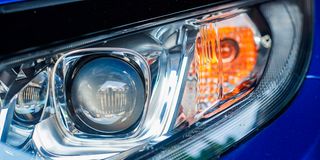Premium
Motor Clinic: Let’s shed the spotlight on bulbs and laws

Modern bulb technology makes standard headlamps potentially many, many times brighter than they used to be.
Spotlights used to be a common accessory on many private cars, but nowadays, they seem to be fewer. Why is this? I am also curious to know the difference between spotlamps with patterned glass and those with plain glass.
Ibrahim
Short answer: Modern bulb technology makes standard headlamps potentially many, many times brighter than they used to be, and much more energy efficient than old incandescent bulbs.
The latest technology generates up to 10 times more lumens per watt through systems such as High Intensity Discharge (HID) and Light Emitting Diodes (LED).
These have been progressively replacing the former “incandescent” bulb and even the improved “quartz halogen” technology over several decades and are becoming the universal standard.
The need for additional spotlamps to provide brighter and whiter light is therefore much reduced to near nil for normal motoring conditions.
Longer answer: What spotlights offer is powerful and highly focused beams that illuminate for a greater distance; further ahead. But even this attribute is being challenged by some recent designs using twin headlamps – one a conventional “reflector” light to give a wide field of view immediately ahead of the vehicle, and the other a high-tech “projector” light with a more piercing long-distance beam. These are effectively built-in spotlights.
The remaining advantage of separate spotlights (and various other auxiliary lights) is the flexibility of their mounting position, which can be at different heights (for instance above water and mud) and be angled in a wider range of directions in circumstances and locations where motoring is not ordinary. And in Kenya there are plenty of those.

What spotlights offer is powerful and highly focused beams that illuminate for a greater distance; further ahead.
The law
It is in that context that some types of auxiliary lights still have an important role to play for many motorists. Their use is restricted, but their fitting is legally permitted. I am not aware of any law which prohibits them, and there are laws that specifically allow them.
For example, Rule 23(5) of the Traffic Act authorises the use of spotlights or a swiveling light instead of headlights “to complete a journey where the headlights have been damaged”. Such an exemption could not exist if the fitting of spotlights was forbidden.
The over-riding principle of all lights – standard or auxiliary - is that they should not be used in a way that impairs the vision of, or causes annoyance to, any user of the road, a consideration that could be usefully applied to out-door loudspeakers in public places…
Legitimate auxiliary lights include spotlamps, fog lamps, searchlights, LED bars, and single swivel lights. They are all potentially useful and can be essential. All must be mounted in compliance with general safety standards and colour codes: front (white or yellow) and rear (red).
They pose no inherent danger or annoyance if they are not misused. If things were prohibited because they were capable of being dangerous if misused, cars themselves would be banned!
All powerful lights can present a severe glare challenge to traffic in front of or approaching the source. On a busy public road, generally only low beam (dip) headlamps (and sometimes foglamps) should be used.
Spotlamps, LED bars and swivel lights should never be used where there is any traffic at all. On a ranch, crossing the Chalbi Desert, on remote safari tracks, off road, on completely empty stretches of road, for search and rescue, for illuminating the scene of an emergency and dozens of other situations. And for all of those, the lights need to be on the car all the time to be immediately available
The law has nothing to say about auxiliary lights if they are properly mounted and turned off. The Traffic Act Rules apply only when and where they are turned on. Rotating or flashing lights are reserved for licenced emergency services, and “gimmick” lights (for instance in radiator grilles) have no legitimate purpose or place on public roads.

Car headlamp.
By the way, high powered spotlights should always be wired through a relay for maximum brightness (your headlamps are), and use an independent switch that can turn them off completely and turn them on only when the headlamps are also on and at high (full) beam. That means dipping your headlights will turn the spotlights off automatically.
Technical advances
Almost all headlamps and spotlamps, ancient and modern, have four main components. In the middle, a bulb that generates light, behind that a (silver) reflector dish that focuses and directs the beam of light forwards with maximum efficiency, in front of that a glass lens that has riffles (what you have called patterns) to shape the beam and fine-tune its direction, and then a mountable housing for the whole assembly. This combination was simplified by sealed beam headlamps, which joined the bulb filament, reflector and lens into a single, inseparable big bulb component.
All standard car bulbs used to be the “incandescent” type, which was cheap to make and lasted quite well up to powers of circa 60W. The lifespan of higher wattage was compromised because the filament was likely to burn out. They were also inefficient, as a high proportion of the electrical energy supplied to them was converted into heat more than light.
Energy efficiency and brightness was improved by the introduction of Quartz Halogen bulbs, which can handle higher wattages (up to 130W) and still have a good lifespan. As the legal maximum for headlamps was only 55W for beam and 45W for dip, QH bulbs were originally single filament intended for spotlights only.
However, they were soon produced as double filament, with high and low beam, with wattages both at, or way above, the legal maximum. The dazzling consequences in this market of headlamp bulbs with double the legal power have been apparent for many years. Incidentally, there are also legal limits for the power of tail-lights, brake lights, indicators and rear fog lamps (red).
Quartz Halogen has in turn has been superseded by HID and LED systems, which have a very much better light-to-heat ratio, use less electrical power and yet have very much brighter and whiter output.
Because the way they generate light is so different from the incandescent option, a comparison of wattage is misleading. Instead their light is measured in lumens or candela. The law has some catching up to do.
The latest technology has also enabled a trend towards plain glass lenses, with the fine-tuning of beam shape now achieved through riffles in the reflector instead of the glass. That partly answers your second question: Riffled lenses diffuse the light and slightly reduce the final level of illumination. For spotlamps, where the shape of the beam from the plain reflector may not need additional shaping, plain glass can be a slightly brighter option.
In the pipeline: Two million people are looking for a representative…where are you? And, ‘How to Become a Better Driver’.
Dear motorists, (and traffic police), let’s support the growing number of cycling enthusiasts

Team Amani cyclists.
Hi Gavin,
I've been an avid reader of your articles over the years. Thank you for your informative pieces. I read with particular interest the article on roof loads because I'm a cyclist. I've been harassed by the police here and there when carrying my bikes around.
Their "overloading" claims vary wildly, and differ from place to place so I keep a copy of the Traffic Act on my phone, and refer them to it when I need to. At full bicycle load, I carry three bikes on the tailgate-mounted carrier, and three more on the roof mounted carrier on my Subaru Outback. From the rear, my tail lights and indicators, plus the number plates, are always clearly visible as you'll see in the attached picture.
This information (especially section 55 (2) of the Traffic Act) needs to be available to the public especially now that more of us are embracing active lifestyles that require us to carry external loads on our cars.
Steve M
Your note adds another strong example of the difference between what the law is and what traffic checks think it is or claim it to be. Let’s hope the announced crackdown on auxiliary lights is less anomalous.
The huge range of different general and specialist roof racks underlines the universality of legitimate roof loads. Many cars have built-in roofrack mounting points (and strong rain gutters), flush and raised roof rails fitted as standard, and there are global suppliers of crossbars for rails, tub racks, carrier platforms, carrier basket racks and trays, solar panels, roof boxes, roof bags, roof tents, tailgate trays and racks, tow-hitch racks and boxes, cycle racks, boat cradles, loading slides, ladders.
Traffic regulators might find it informative to look at a few websites for those, and for auxiliary lights.
On a brighter note, it is good to see that cycling is gaining momentum as a recreation and a competitive sport in Kenya. Altitudes, gradients and road conditions don't make either recreational riding or serious training an easy task, but those same factors - and Kenya's inherent pre-eminence in equivalent athletics events - suggest many who do conquer the challenges of cycling in our environment are likely to become very good at it; more than a few could be world class.
Perhaps here and now is an opportunity to encourage traffic administrators to support the growing numbers of enthusiasts rather than hassling them, and to ask motorists to celebrate the sight of a colourful helmet atop a dedicated athlete and give maximum consideration to their right to ride and their safety.





